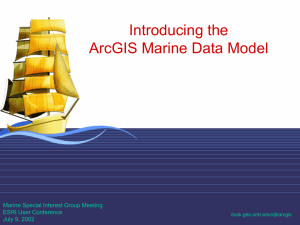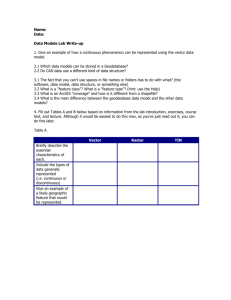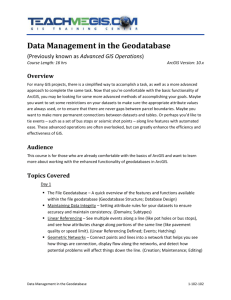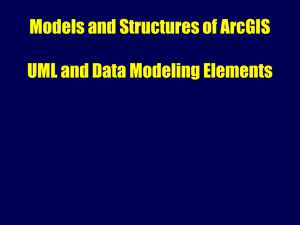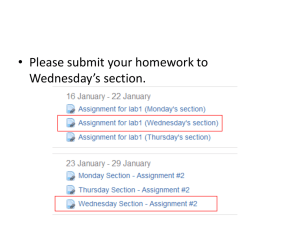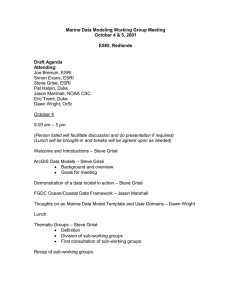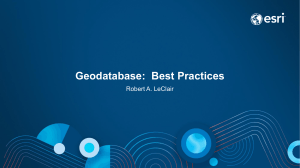ArcGIS Marine Data Model Project Introduction Conceptual Framework Dawn Wright, Oregon State University
advertisement
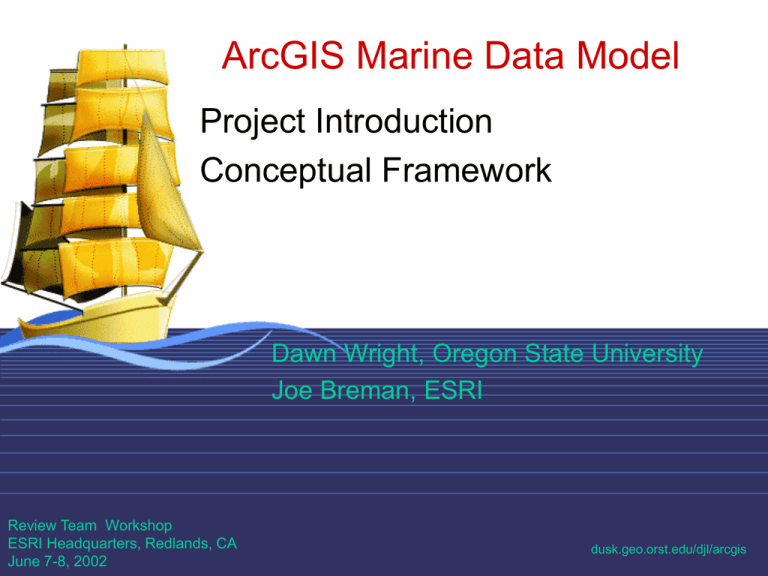
ArcGIS Marine Data Model Project Introduction Conceptual Framework Dawn Wright, Oregon State University Joe Breman, ESRI Review Team Workshop ESRI Headquarters, Redlands, CA June 7-8, 2002 dusk.geo.orst.edu/djl/arcgis 1 Workshop Goals • Overview of process • Refine the initial concepts and technical structure of the model • Test model's initial application to real data • Discussion of case studies, SIG meeting, further steps • Agenda and handouts 2 Project Overview • Steps in Process • Conceptual Framework – 50 pg. draft at dusk.geo.orst.edu/djl/arcgis • Lead in to demos and discussion 3 Steps in Data Model Process • Data model template – few weeks to months • Mature data model – up to few years • more info at dusk.geo.orst.edu/djl/arcgis/about.html Draft Model Review, Projects Final Model 4 Project Milestones • Initial Working Group - Oct. 4-5, 2001 – Steve Grisé, Joe Breman, Simon Evans – Dawn Wright, Jason Marshall, Pat Halpin, Eric Treml – Analysis Diagram, UMLs, Data Structures • Draft Conceptual FW Document – Nov. 2001 • Review Team, Case Studies, and Interested Participants • This workshop – Jun. 7-8, 2002 • Marine SIG Meeting at ESRI UC,July 9, 2002 5 Purpose of Marine Data Model • basic template for implementing GIS projects – input, formatting, geoprocessing, creating maps, performing analyses • basic framework for writing program code and maintaining applications – development of tools for the community • promote networking and data sharing through established standards • Learning,understanding ArcGIS! 6 Georelational to Geodatabase Model • coverage and shapefile data structures • features are aggregated into homogenous collections of points, lines, and polygons with generic, 1- and 2-dimensional "behavior" • can’t distinguish behaviors – Point for a marker buoy, same as point for OBS • “smart features” in a geodatabase 7 Geodatabase Concepts • ESRI's new data object-oriented data model – objects, features, behaviors • Object – in ArcGIS an object is non-spatial • it is NOT a point, line, or area • it has no geographic location – it has no shape attribute in its table – ship, vehicle, … customer, lake, house • Feature – an object that has geographic location – a point, line, area, TIN, raster 8 Geodatabase Concepts ( cont. ) • Geodatabase – collection of feature data sets, rasters, TINs – all data in relational tables – behavior is coupled with features through rules – no more division between ARC and INFO 9 Transition to ArcGIS 8? • how and when to do it? • How well are marine application domain requirements met in the geodatabase structure now? • What can we do as a group to understand the technology and identify requirements? • What are the potential benefits? 10 Marine Data Layers Bathymetry Shoreline Marine boundaries Geophysical time series Sub-bottom profiling Sidescan sonar Magnetics Gravity Seismics Atmospheric influences Sea state Sea surface Temperature Salinity Sensor calibration data Current meters Density Sediment transport Wave activity 11 Monterey Bay Bathymetry Planimetric View 12 Faults Draped on Bathy 13 3- and 4-D Analysis Maximizing the use of available tools “Placeholders” for 3-, 4-D data in the model 14 Coastlines and sea level change Raster layers with adjusted base heights 15 16 Geostatistical Integrating Powerful Data Exploration and Surface Creation Environment “3D” Kriging? 17 18 19 Marine Data Collection Image courtesy of PISCO, OSU 20 Steps in Data Modeling (1) Model the user's view of data – what are the basic features needed to solve the problem? (2) Select the geographic representation – points, lines, areas, rasters, TINs (3) Define objects and relationships – draw a UML diagram (4) Match to geodatabase elements – specify relationships, “behaviors” (5) Organize geodatabase structure 21 Users’s View of Data 22 • Time duration areas • Representing dynamic marine data • Instantaneous points with multiple z values • Feature locations change • Tracking marine animal movement • Multiple time variable data • A dynamic and multivariable coastline • Bathymetric layers 23 Select Geog. Rep. P. Halpin, Duke University 24 25 Understanding the Design • • • • • Won’t go through all boxes Use ArcMap and real data Data model a great poster? Data maintenance app. Programming framework 26 UML to ArcGIS 8 27 Some Issues • How DOES the model handle time? – especially same feature in different locations over time? – Hydro model time series may not be good equivalent after all • Change in value (flow) for a fixed feature (channel, gauge) • 3D – Many use other software for true 3D analysis (Fledermaus, Rockware, etc.) – import, conversion to Arc – Geology, geophysics, phys. oceanography software • Coastal vs. deepsea balance • General Data Structures – Your data may not immediately fall into present schema categories – Shouldn’t be a problem with the structure. • Others? 28
